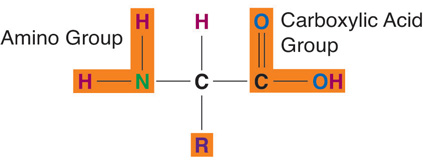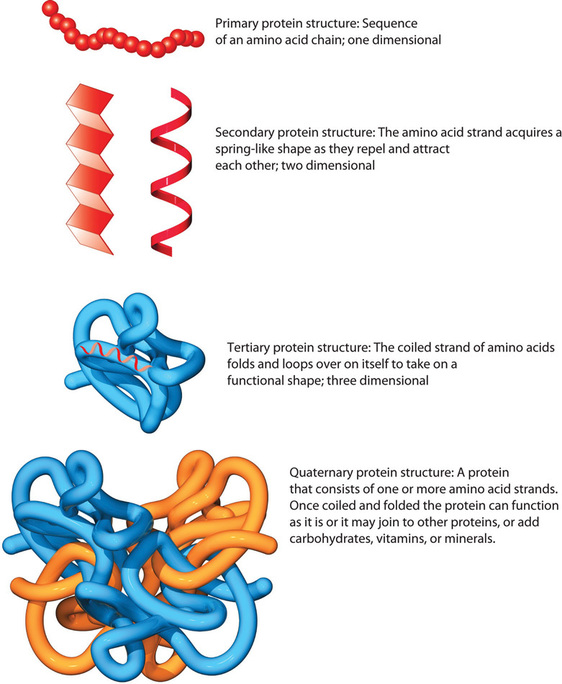7.2 – Defining Protein
Learning Objectives
- Categorize the different types of amino acids.
- Describe how protein differs in structure from carbohydrates and lipids.
Protein makes up approximately 20 percent of the human body and is present in every single cell. The word protein is a Greek word, meaning “of utmost importance.” Proteins are called the workhorses of life as they provide the body with structure and perform a vast array of functions. You can stand, walk, run, skate, swim, and more because of your protein-rich muscles. Protein is necessary for proper immune system function, digestion, and hair and nail growth, and is involved in numerous other body functions. In fact, it is estimated that more than one hundred thousand different proteins exist within the human body. In this chapter, you will learn about the components of protein, the important roles that protein serves within the body, how the body uses protein, the risks, and consequences associated with too much or too little protein, and where to find healthy sources of it in your diet.

By LauraHale – Own work, CC BY-SA 3.0
What Is Protein?
Proteins, simply put, are macromolecules composed of amino acids. Amino acids are commonly called protein’s building blocks. Proteins are crucial for the nourishment, renewal, and continuance of life. Proteins contain the elements carbon, hydrogen, and oxygen just as carbohydrates and lipids do, but proteins are the only macronutrient that contains nitrogen. In each amino acid, the elements are arranged into a specific conformation around a carbon center. Each amino acid consists of a central carbon atom connected to a side chain, hydrogen, a nitrogen-containing amino group, and a carboxylic acid group—hence the name “amino acid.” Amino acids differ from each other by which specific side chain is bonded to the carbon center.

A carbon atom is attached to 4 items: hydrogen above, a carboxylic acid group to the right, a side chain or R group below, and an amino acid group to the left.
It’s All in the Side Chain
The side chain of an amino acid, sometimes called the “R” group, can be as simple as one hydrogen-bonded to the carbon center, or as complex as a six-carbon ring bonded to the carbon center. Although each side chain of the twenty amino acids is unique, there are some chemical likenesses among them.
Essential and Nonessential Amino Acids
Amino acids are further classified based on nutritional aspects. Recall that there are twenty different amino acids, and we require all of them to make the many different proteins found throughout the body. Eleven of these are called nonessential amino acids because the body can synthesize or make them. However, nine of the amino acids are called essential amino acids because we cannot synthesize them either at all or in insufficient amounts. These must be obtained from the diet. Sometimes during infancy, growth, and diseased states, the body cannot synthesize enough of some of the nonessential amino acids and more of them are required in the diet. These types of amino acids are called conditionally essential amino acids. The nutritional value of a protein is dependent on what amino acids it contains and in what quantities.
The Many Different Types of Proteins
As discussed, there are over one hundred thousand different proteins in the human body. Different proteins are produced because there are twenty types of naturally occurring amino acids that are combined in unique sequences. Additionally, proteins come in many different sizes. The hormone insulin, which regulates blood glucose, is composed of only fifty-one amino acids; whereas collagen, a protein that acts like glue between cells, consists of more than one thousand amino acids. Titin is the largest known protein. It accounts for the elasticity of muscles, and consists of more than twenty-five thousand amino acids! The abundant variations of proteins are due to the unending number of amino acid sequences that can be formed. To compare how so many different proteins can be designed from only twenty amino acids, think about music. All of the music that exists in the world has been derived from a basic set of seven notes C, D, E, F, G, A, B and variations thereof. As a result, there is a vast array of music and songs all composed of specific sequences from these basic musical notes. Similarly, the twenty amino acids can be linked together in an extraordinary number of sequences, much more than are possible for the seven musical notes to create songs. As a result, there are enormous variations and potential amino acid sequences that can be created. For example, if an amino acid sequence for a protein is 104 amino acids long the possible combinations of amino acid sequences is equal to 20104, which is 2 followed by 135 zeros!
Protein Organization
Protein’s structure enables it to perform a variety of functions. Proteins are much more structurally complex than carbohydrates or lipids. In contrast to carbohydrates, which have identical repeating units, proteins are made up of amino acids that are different from one another. Furthermore, a protein is organized into four different structural levels (Figure 6.5). The first level is the one-dimensional sequence of amino acids that are held together by peptide bonds. The two-dimensional level of protein structure is dependent on the chemical interactions between amino acids, which cause the protein to fold into a specific shape, such as a helix (like a coiled spring) or sheet. The third level of protein structure is three-dimensional. As the different side chains of amino acids chemically interact, they either repel or attract each other, resulting in the coiled structure. Thus, the specific sequence of amino acids in a protein directs the protein to fold into a specific, organized shape. The fourth level of structure (also known as its “quaternary” structure) is achieved when protein fragments called peptides combine to make one larger functional protein. The protein hemoglobin is an example of a protein that has a quaternary structure. It is composed of four peptides that bond together to form a functional oxygen carrier. A protein’s structure also influences its nutritional quality. Large fibrous protein structures are more difficult to digest than smaller proteins and some, such as keratin, are indigestible. Because digestion of some fibrous proteins is incomplete, not all of the amino acids are absorbed and available for the body to utilize, thereby decreasing their nutritional value.

The 4 structural levels of a protein. 1. Primary: sequence of an amino acid chain; one dimensional like a chain of beads; 2. secondary: a spring-like shape as they repel and attract each other, like a spiral or set of stairs; 3. tertiary: coiled strands of amino acids fold and loop over on itself to take on a functional shape, 3 dimensional; 4. quaternary: consists of one or more amino acid strands. Once oiled and folded, the protein can function as it is, or it may join to other proteins, or add carbohydrates, vitamins or minerals.
See the process of building a protein in real-time in this animation.
Key Takeaways
- Amino acids differ chemically in the molecular composition of their side chains, but they do have some similarities.
- Amino acids are also categorized based upon their nutritional aspects. Some are nonessential in the diet because the body can synthesize them, and some are essential in the diet because the body cannot make them.
- Proteins are amino acids held together by peptide bonds.
- Proteins have up to four different levels of structure, making them much more complex than carbohydrates or lipids.
Discussion Starters
- There are over four thousand diseases caused by the incorrectly built protein. Find out more about how one incorrectly placed amino acid causes the disease sickle cell anemia by watching this animation.
- Why do you think protein-building diseases are rare? In every cell in your body, over ten million ribosomes are at work constructing millions of proteins every minute. What can you say about the body’s amazing track record in correctly building proteins?

